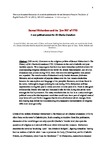Samuel Richardson and the "Jew Bill" of 1753: A new political context for Sir Charles Grandison
| dc.contributor.author | Latimer, B | |
| dc.date.accessioned | 2015-10-08T09:12:26Z | |
| dc.date.accessioned | 2016-07-11T09:42:53Z | |
| dc.date.available | 2015-10-08T09:12:26Z | |
| dc.date.available | 2016-07-11T09:42:53Z | |
| dc.date.issued | 2015 | |
| dc.identifier.issn | 0034-6551 | |
| dc.identifier.issn | 1471-6968 | |
| dc.identifier.uri | http://hdl.handle.net/10026.1/5038 | |
| dc.description.abstract |
Analysis of the religious politics of Samuel Richardson’s The History of Sir Charles Grandison (1753-4) focuses on the text’s Catholic and post-Jacobite aspects. This essay argues that there is a more immediate political context for understanding religious tolerance in the novel: the Jewish Naturalisation Act of 1753. Grandison was printed during 1753, when this controversial legislation was passed and repealed. The novel contains Richardson’s only Jewish character, Solomon Merceda, and an exploration of debate over the Act reveals similarities between the assumptions and language of the pamphlet literature, and those found in the novel. Although he began printing his text during 1753, Richardson still had opportunities during this year to revise and even to write parts of it. There is also evidence that friends who read and discussed drafts for him during this period were amongst the Act’s promoters. The essay concludes that the Act is an unacknowledged political context for this important novel that would have been part of original readers’ experience of it, and suggests that the idea of tolerance which emerges from this reading may inflect our understanding of Grandison’s representation of religious difference more generally. | |
| dc.format.extent | 520-539 | |
| dc.language | en | |
| dc.language.iso | en | |
| dc.publisher | Oxford University Press | |
| dc.relation.replaces | http://hdl.handle.net/10026.1/3581 | |
| dc.relation.replaces | 10026.1/3581 | |
| dc.subject | 47 Language, Communication and Culture | |
| dc.subject | 4703 Language Studies | |
| dc.subject | 4705 Literary Studies | |
| dc.title | Samuel Richardson and the "Jew Bill" of 1753: A new political context for Sir Charles Grandison | |
| dc.type | journal-article | |
| dc.type | Article | |
| plymouth.issue | 275 | |
| plymouth.volume | 66 | |
| plymouth.publication-status | Published | |
| plymouth.journal | The Review of English Studies | |
| dc.identifier.doi | 10.1093/res/hgu112 | |
| plymouth.organisational-group | /Plymouth | |
| plymouth.organisational-group | /Plymouth/Faculty of Arts, Humanities and Business | |
| plymouth.organisational-group | /Plymouth/REF 2021 Researchers by UoA | |
| plymouth.organisational-group | /Plymouth/REF 2021 Researchers by UoA/UoA27 English Language and Literature | |
| plymouth.organisational-group | /Plymouth/Users by role | |
| plymouth.organisational-group | /Plymouth/Users by role/Academics | |
| dc.identifier.eissn | 1471-6968 | |
| dc.rights.embargoperiod | Not known | |
| rioxxterms.versionofrecord | 10.1093/res/hgu112 | |
| rioxxterms.licenseref.uri | http://www.rioxx.net/licenses/all-rights-reserved | |
| rioxxterms.type | Journal Article/Review |


